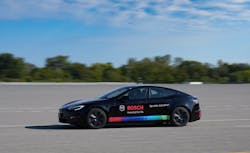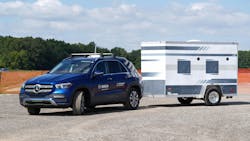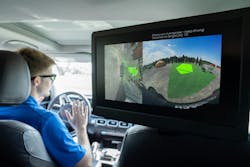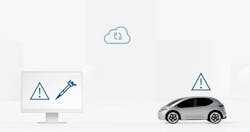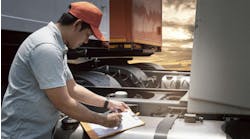What does the future of mobility look like? Is it flying cars or hovercrafts? Could vehicles still use roads, but each become embedded with autonomous software? Will innovations only be available for consumer markets? Or will commercial vehicles benefit, too?
No one knows the future, but the minds behind shaping mobility for tomorrow sometimes give the media a taste of innovations that could likely come down the pipeline. Bosch being one of them.
Earlier this month in Michigan, Bosch Mobility hosted media to showcase multiple new safety, connectivity, and trailering technologies that are currently available for OEMs to implement into their new models. These innovations in safety and convenience in automotive could easily be adapted to the fleet segment.
See also: Future models: OEMs, startups show off new trucks and vans at ACT Expo
Bosch safety innovations
You might have heard the phrase “by-wire” at trade shows or even dealer showrooms, but essentially “by-wire” technology replaces mechanical processes, such as braking and steering, with an electronic process. By-wire technology is something that is steadily creeping its way into the automotive sector, as multiple vehicles on the roads today are equipped with the technology.
Steer-by-wire
With steer-by-wire technology, there is no physical connection between the steering wheel and the vehicle’s front tires. Instead, sensors are used to determine which direction the driver turns the wheel, and then the system adjusts the vehicle’s tires accordingly.
Bosch Mobility took steer-by-wire a few steps further, adding its “Vehicle Motion Management” technology to a Lucid Air with steer-by-wire technology for demonstration purposes.
In the demo, media attendees were asked to perform a hard brake on a wet course and perform multiple swerving steering motions.
Steer-by-wire eliminates the need for a physical force on the steering wheel and enables the vehicle’s technology to adapt steering in emergency situations. Input on the steering wheel can also be adjusted for sensitivity based on needs and desires (or to decrease fatigue when driving long hours). Bosch’s Vehicle Motion Management also features a multi-actuator that gives the vehicle a short braking distance with less driver intervention, increasing safety.
Brake-by-wire
As with steer-by-wire, brake-by-wire replaces the physical interaction between the driver’s foot on the brake pad and the hydraulic braking system and replaces it with electronic sensors. If a sensor is activated through the driver’s pressure on the brake pedal, the mechanical braking system is activated electronically. Brake-by-wire is available on multiple vehicles today, from the Chevrolet Trailblazer to the Porsche Taycan.
However, once again, Bosch took brake-by-wire a step further with its Braking Control Pad, which removes the physical movement of the brake pedal and instead increases braking intensity by the amount of pressure drivers place on a fixed pad. Bosch says this method of braking results in less effort to fully stop a vehicle. Bosch also said it improves safety by reducing “the number of left-hand and right-hand drive vehicles, incorporating redundancy in the design.”
Media tested the brake-by-wire and Braking Control Pad on a Tesla Model 3.
Vehicle dynamics control 2.0
Bosch’s vehicle dynamics control 2.0, made possible through by-wire technology, can vastly improve vehicle safety.
Media experienced vehicle dynamics control 2.0 in the Lucid Air. They were instructed to simulate a situation where one might swerve into the opposite lane to avoid an animal on the road. At that point, Bosch’s technology will take over to return the vehicle back to the correct lane, preventing any head-on collisions. While the circumstance can be explained in a few sentences, it’s the technology behind the innovation that’s impressive.
With Bosch technology integrated into the vehicle, vehicle dynamics control 2.0 can “think ahead” for the vehicle and the driver. From the vehicle’s sensors, the system can intervene on unsafe behaviors proactively, “acting instead of reacting,” Bosch states.
While the technology was tested on an EV, it’s scalable for all powertrain configurations and vehicle segments, features flexible deployment on braking systems or central control units, and offers increased comfort, controllability, agility, and safety.
See also: FMCSA’s plans for AEB systems, speed limiters
Trailering technology
One of Bosch’s innovations that could enhance the lives of many fleet vehicle drivers of today is its new trailering technology. These new features turn autonomous driving into a handy tool, allowing vehicles to maneuver a trailer on their own.
Trailer hitch guidance
Using sensors and a camera, Bosch Mobility technology enables vehicles to move a hitch under a trailer completely independent of driver—or spotter—assistance. This technology offers precise alignment using a camera and hardware that nearly every new vehicle is already equipped with—no additional OEM or aftermarket hardware required.
Anywhere parking
Once the trailer is hitched to the vehicle, using a center touchscreen infotainment system that, again, is already equipped on most new vehicles, drivers can touch their screen and determine the exact reverse direction they want their trailer to maneuver. This feature would work well for fleet owners who need to reverse in congested urban areas or woody rural areas. Once a direction has been decided and the driver removes their hands from the steering wheel, the vehicle, and Bosch technology does the rest of the work.
If the direction needs adjustment, drivers only need to press the brake pedal and indicate the new direction with their finger on the screen. This technology was demonstrated on a Mercedes GLE SUV.
What’s more, using surround-view cameras that are largely already available on new vehicles, drivers can use the touchscreen to indicate the exact location to park the trailer. Once a location has been determined, drivers can even indicate which direction the trailer should face. After a driver determines the location and removes their hands from the steering wheel, the vehicle completes the job autonomously. This technology was demonstrated in a Ford F-150.
See also: Tackling fleet safety challenges with trailer technology
Cloud connectivity
For fleets, connectivity, telematics, and management software is a necessity. Those with EVs in their fleets or with sustainability goals can gather even more value from connectivity.
Battery in the cloud
Bosch’s Battery in the Cloud can help fleets monitor the performance of their EV battery to ensure they can use the EV as long as possible.
“If I own an electric vehicle, I want to make sure that I use it for as long as possible,” said Utkarsha Atkare, a senior software engineer at Bosch. “For fleet owners, it’s in their interest that they ... use [their EV] for as long as possible. They don’t have to encounter some warranty issues or battery replacement issues and so on.”
The Battery in the Cloud works by “extracting basic battery data, like temperature, voltage, current, and state of charge of the battery,” Atkare told FleetOwner.
Battery in the Cloud software, which digitizes battery management, provides a look at battery performance optimization, real-time battery monitoring, and battery analysis.
Using this technology can help fleet owners discover anomalies in battery performance and predict battery performance across various vehicle types and models.
Digital fuel twin
Fleets living in areas with restrictions and regulations on their emissions output or those with strict environmental and sustainability goals will find benefit in Bosch’s Digital Fuel Twin.
The Digital Fuel Twin, in collaboration with fuel manufacturers and filling station operators, enables fleets to track their vehicle fuel properties across the entire supply chain. This is possible through a “digital handshake,” or what Bosch explains is an exchange of data between the cloud, the filling station, and the vehicle. This technology also offers audit-ready certificates that document the actual carbon footprint of their vehicles for all fuel types.
The Digital Fuel Twin completely digitizes the tracking and certification of fuel properties from fuel production to the vehicle’s fuel tank, and it requires no additional sensors. Fleet owners can track these fuel properties on a dashboard that displays performance indicators and key metrics. The technology is available independent of payment method and independently of the vehicle holder or second-hand sales.
“A digital tag will be assigned for every step of fuel delivery,” Uday Rajanala, a Bosch senior software engineer, told FleetOwner. “Right from the refinery, we identify what kind of fuel is being generated and how much amount of fuel is being generated, how much it is, and how much fuel has been transmitted with the help of a fuel card.
“From the vehicle, we receive how much fuel and what type of fuel has been filled in the vehicle,” he said. “From this, we know what is the real carbon footprint that has been consumed, and we generate a certificate for the vehicle.”
See also: Fleets Explained: Emissions regulations
Predictive diagnostics
Bosch’s cloud-based predictive diagnostics combines cloud monitoring and predictive analytics to improve maintenance and benefit fleet owners. This technology integrates into existing telematics systems to help predict equipment failure, proactively address maintenance needs, and identify potential issues.
“Fault codes would be the focus, and we would be bringing not only the translation [of the fault code], but we also talk about severity, priority, and if it’s safety relevant or not,” Rodrigo Oliveira, another senior software engineer at Bosch, told FleetOwner. “Criticality assessment and severity is something exclusive to our product. That comes from our know-how [at Bosch].”
Benefits include: precise pinpointing of failures with easy root cause identification; compatibility with non-Bosch components; increased uptime; and reduced maintenance costs.
Innovation for the future
While some OEMs have developed this technology on vehicles already available in the market, with Bosch’s OEM-agnostic technology, the innovative technology showcased in Michigan earlier this month could potentially increase the safety and connectivity of every vehicle on the road—including commercial vehicles.


